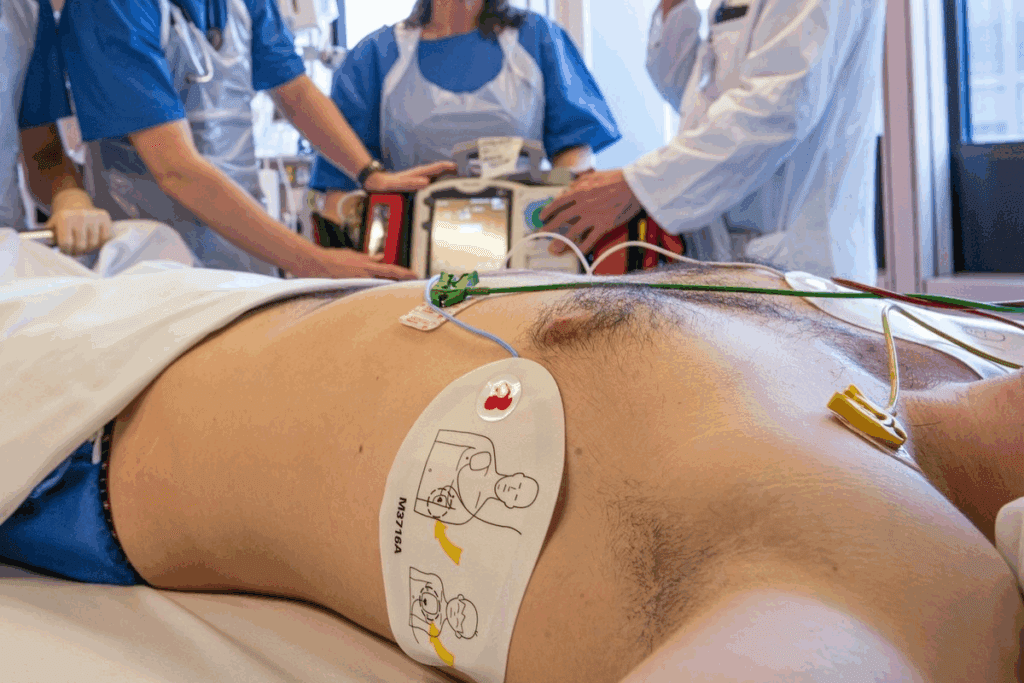
Learn how to stop fibrillation and manage AFib attacks safely at home.
Atrial fibrillation (AFib) is a common heart rhythm disorder that affects millions worldwide. It increases the risk of stroke and heart failure. A quivery heartbeat and a flutter in your chest are signs you’re experiencing AFib. This means your heart is beating out of sync.
Managing AFib episodes at home is key for those with this condition. Knowing how to regain control during an episode can lessen discomfort and anxiety.
At Liv Hospital, we focus on innovative care and patient-focused excellence. We’ll teach you important techniques, like breathing exercises and vagal maneuvers. These can help manage AFib attacks effectively.

Atrial fibrillation, or AFib, is when the heart’s upper chambers beat chaotically. This can make the heart beat too fast or too slow. It can cause symptoms that affect your daily life.
During an AFib episode, the heart’s rhythm is disrupted. This can make the heart beat over 100 times per minute. Various factors like stress or caffeine can trigger these episodes.
“AFib is not just a minor irregularity in heart rhythm; it’s a serious condition that requires attention and management,” says a leading cardiologist. Knowing the symptoms and what happens during an episode is key for managing it.
It’s important to know the symptoms of AFib. Common signs include:
These symptoms can be scary and affect your daily life. Knowing them can help you manage your condition better.
If AFib is not treated, it can lead to serious problems. One big risk is stroke, because the irregular heartbeat can cause blood clots. Other complications include heart failure, which can make the heart less efficient over time. It’s critical to seek medical attention if symptoms don’t go away or get worse.
Knowing the risks of untreated AFib shows why getting medical help is so important. By managing AFib, you can lower your risk of these problems and live a better life.

When an AFib attack happens, knowing how to react is key. Staying calm and acting right can help manage the situation well.
The first thing to do is stay calm. Panicking can make your heart rate go up and make symptoms worse. Breathe slowly and deeply, and try to relax. Check your symptoms: Are you feeling irregular heartbeats, shortness of breath, or chest pain? Knowing how bad your symptoms are will help you decide what to do next.
If you have severe symptoms like chest pain, trouble breathing, or feeling dizzy, call emergency services right away. AFib can sometimes lead to serious problems like stroke or heart failure. If you’re not sure how bad your symptoms are, it’s safer to get medical help.
Keep an eye on your heart rate and blood pressure during an AFib attack. Use a device at home to track these important signs. This info helps your doctor figure out the best plan for you. Keeping a record of your readings can also show patterns and what might trigger AFib.
By staying calm, checking your symptoms, knowing when to call for help, and watching your vital signs, you can handle an AFib attack at home. Always talk to your doctor for advice on dealing with AFib episodes.
When you have an AFib episode, using the right methods can ease symptoms and stop the fibrillation. We’ll look at some quick ways to manage AFib episodes.
If your AFib symptoms are bad or last a long time, knowing when to get emergency help is key. If you have chest pain, can’t breathe well, or feel dizzy, call for help right away.
Emergency Response Checklist:
Simple changes in how you sit or lie down can help with AFib symptoms. Lying down or raising your legs can improve blood flow and lessen symptoms.
| Position Change | Potential Benefit |
| Lying down | Improves blood flow to the brain and other vital organs. |
| Elevating legs | Enhances venous return, potentially stabilizing heart rhythm. |
It’s important to calm your nervous system during an AFib episode. Techniques like slow, focused, abdominal breathing can relax you and your heart.
To practice deep breathing:
By adding these quick techniques to your AFib management plan, you can lessen how often and how bad episodes are.
AFib episodes can be tough to handle, but breathing techniques can help. By adding these methods to your daily life, you can manage AFib better. This can also reduce its impact on your life.
Deep diaphragmatic breathing is a quiet, slow breathing method. You breathe in through your nose, hold it, and then breathe out slowly through your mouth. This method can slow your heart rate and lower stress.
To practice deep diaphragmatic breathing:
Box breathing is another great way to handle AFib episodes. It’s about breathing in for 4 counts, holding for 4 counts, exhaling for 4 counts, and holding again for 4 counts. This creates a “box” shape with your breath, helping you relax and stay calm.
To practice box breathing:
Guided breathing exercises can also help manage AFib. These exercises follow a guide or instructor. They lead you through different breathing patterns and relaxation techniques.
A comparison of the different breathing techniques is shown in the table below:
| Technique | Description | Benefits |
| Deep Diaphragmatic Breathing | Slow, deep breaths through the nose, holding, and slow exhalation | Reduces stress, slows heart rate |
| Box Breathing | Breathing in, holding, exhaling, and holding again for equal counts | Promotes relaxation, reduces anxiety |
| Guided Breathing Exercises | Following a guide through various breathing patterns | Enhances relaxation, reduces symptoms |
By adding these breathing techniques to your daily routine, you can better manage AFib episodes. This can also improve your overall well-being.
Vagal maneuvers are a simple way to manage Atrial Fibrillation (AFib) by stimulating the vagus nerve. They can slow the heart rate. These methods are easy to do at home and can help reduce AFib episodes.
The Valsalva maneuver is a common technique. It makes you bear down like you’re having a bowel movement. This increases pressure and stimulates the vagus nerve.
This can slow your heart rate and possibly change AFib to a normal rhythm.
Coughing is another effective method. It increases chest pressure, helping to regulate heart rhythm. To cough effectively:
Coughing is great during an AFib episode. It’s an immediate way to try and restore a normal heart rhythm.
Cold water facial immersion involves putting your face in cold water. It’s a good way to slow your heart rate and manage AFib. To do it:
This method works well because of the sudden cold. It stimulates nerve endings in your face and helps control your heart rate.
| Technique | Description | Potential Benefits |
| Valsalva Maneuver | Bearing down as if having a bowel movement | Slows heart rate, potentially converts AFib to normal sinus rhythm |
| Coughing Technique | Forceful coughing | Regulates heart rhythm, immediate action during AFib episode |
| Cold Water Facial Immersion | Submerging face in cold water | Slows heart rate, stimulates vagus nerve |
Always talk to a healthcare provider before trying these techniques, if you have health issues. While vagal maneuvers can be helpful, they’re not for everyone.
“The application of vagal maneuvers represents a straightforward yet effective method for individuals to potentially cease AFib episodes.”
Medical Expert
Living with AFib means learning to relax and manage stress. These skills can control the condition. We’ll look at techniques that help calm AFib episodes and reduce symptoms.
Progressive muscle relaxation involves tensing and relaxing muscles. It releases physical tension and eases AFib symptoms. Start by tensing your toes, then move up to your head, holding each muscle for a few seconds before releasing.
Meditation and mindfulness reduce stress and promote relaxation. They help manage AFib episodes. These practices focus on the present moment, often through breathing or guided imagery. Regular meditation can lessen AFib episodes.
Gentle yoga poses can ease AFib symptoms by promoting relaxation. Poses like child’s pose, downward-facing dog, and seated forward bend calm the nervous system. Always practice with a qualified yoga instructor who knows about AFib.
Adding these relaxation methods to your daily routine can help manage AFib. Regular practice reduces stress, improves heart health, and brings calm.
Making lifestyle changes is key to reducing AFib episodes and improving health. By adding healthy habits to your daily routine, you can better manage your condition.
Changing your diet is important for managing AFib. Some foods and drinks can trigger episodes, while others can help prevent them. Cutting down on caffeine and alcohol can ease symptoms. Eating a balanced diet with lots of fruits, vegetables, and whole grains also boosts heart health.
| Food Category | Recommended Foods | Foods to Avoid |
| Beverages | Water, herbal teas | Caffeine, alcohol |
| Fruits | Berries, citrus fruits | Fruits high in sugar |
| Grains | Whole grains | Refined grains |
A study in the Journal of the American College of Cardiology found that diet changes can help manage AFib.
“A healthy diet, combined with regular physical activity, can reduce the frequency and severity of AFib episodes.”
Regular exercise is vital for managing AFib. It helps keep a healthy weight, lowers stress, and boosts heart health. Yoga, walking, and swimming are good choices.
Stress can trigger AFib episodes. Using stress management techniques can help lessen episodes. Meditation, deep breathing, and progressive muscle relaxation are good options.
Meditation and mindfulness practices calm the mind and lower stress. Regular use can greatly reduce AFib episodes.
By making these lifestyle changes, you can manage AFib better and improve your life quality.
To fight nighttime AFib, a detailed plan is needed. This plan should include lifestyle changes and better sleep. Dealing with AFib at night can be tough because it messes with sleep and affects health.
Changing how you sleep can help with AFib at night. Elevating your head and sleeping on your side can ease heart pressure. This position improves blood flow and lessens heart strain, which may lower AFib risk at night.
A good sleep space is key for managing AFib at night. Make sure your bedroom is cool, dark, and quiet. Use blackout curtains, earplugs, or a white noise machine for this. Also, get a comfy mattress and pillows to sleep better.
Having a bedtime routine helps your body know it’s time to sleep. This can include relaxation techniques like deep breathing, meditation, or reading. Stay away from screens and exciting activities before bed to keep your sleep cycle natural.
By using these tips, you can manage nighttime AFib better. This improves your sleep and health overall.
To manage AFib well, it’s key to know what to avoid. Certain substances and triggers can make symptoms worse. By steering clear of these, people can lessen how often and how bad their AFib episodes are.
Caffeine and stimulants can set off AFib in many. They make the heart beat faster and irregularly. Coffee, tea, energy drinks, and some meds are common sources of caffeine. Cutting down or stopping caffeine might help AFib symptoms.
Other stimulants, like in some cold meds and supplements, can also cause AFib. Always check with a doctor before taking any new meds or supplements.
Drinking alcohol is another big AFib trigger. The “holiday heart syndrome” shows how too much alcohol can lead to AFib. Even a little alcohol can trigger episodes in some. Knowing your limits and maybe cutting back on alcohol can help manage AFib.
Other foods and activities can also trigger AFib. Some might react to food additives, preservatives, or high-sodium foods. Keeping a food diary can help find out what foods are triggers.
Stressful or intense activities can also trigger AFib. While regular exercise is good, too much can trigger episodes. Stress-reducing activities like meditation or yoga can help.
Knowing about these triggers and making smart lifestyle choices can help manage AFib. This way, people can have fewer and less severe episodes.
When atrial fibrillation (AFib) persists, medical interventions are key. They help manage symptoms and improve heart health. Without treatment, AFib can lead to serious problems.
There are many ways to manage AFib, from medications to procedures. Each option is chosen based on the person’s health and needs.
Medications are vital in managing AFib symptoms. Beta blockers and anti-arrhythmic medications control heart rate and rhythm. They help reduce symptoms like palpitations and shortness of breath.
Dr. John Smith, a cardiologist, says, “Medications are often the first treatment for AFib. They help control symptoms and improve life quality.”
“The goal of medication is to restore a normal heart rhythm and prevent complications associated with AFib.”
Cardioversion is sometimes recommended. It involves a controlled electric shock to restore rhythm. This procedure is done under sedation or anesthesia.
Rhythm control procedures, like catheter-based treatments, aim to keep a normal heart rhythm. They are often used with medications for best results.
Ablation is a procedure that destroys abnormal heart pathways. It’s considered for those who don’t respond to other treatments.
Other treatments, like pacemaker implantation, may be needed for certain heart conditions. They help with continuous monitoring.
Medical interventions are vital for managing persistent AFib. Understanding treatment options helps individuals work with their healthcare providers to find the best plan.
Creating a personal AFib action plan is key to managing atrial fibrillation well. Working with a healthcare provider helps make a plan that fits your needs.
This plan should include lifestyle changes, relaxation methods, and medical treatments when needed. Taking charge of AFib can lessen symptoms and boost health and happiness.
An effective plan lets you manage your AFib better. It helps you make smart choices about your care. We suggest working with a healthcare provider to create a plan that works best for you.
To stop an AFib attack at home, stay calm and try deep breathing exercises. Use vagal maneuvers like the Valsalva maneuver or cold water facial immersion. If symptoms don’t get better, get medical help.
To calm an AFib episode, try relaxation techniques like progressive muscle relaxation or meditation. Gentle yoga poses and deep breathing exercises can also help slow your heart rate and reduce symptoms.
Effective breathing techniques for managing AFib include deep diaphragmatic breathing and box breathing. Guided breathing exercises can also help slow your heart rate, reduce stress, and alleviate symptoms.
Yes, lifestyle changes like reducing caffeine and alcohol, exercising regularly, and managing stress can help reduce AFib episodes. These changes can also improve your overall health.
To manage nighttime AFib, try sleeping on your side with your head elevated. Create a sleep environment that reduces triggers and establish a bedtime routine that promotes relaxation.
To prevent AFib episodes, avoid caffeine and stimulants and limit alcohol. Be aware of hidden triggers in common foods and activities that may worsen symptoms.
Consider medical interventions for AFib if symptoms don’t get better with lifestyle changes and relaxation techniques. Medications, cardioversion, and rhythm control procedures may be needed to manage persistent AFib.
Vagal maneuvers like the Valsalva maneuver, coughing, and cold water facial immersion can help slow the heart rate. They can potentially stop an AFib episode by stimulating the vagus nerve.
To create a personal AFib action plan, work with your healthcare provider. Develop a plan that includes lifestyle changes, relaxation techniques, and medical interventions as needed to manage your AFib and reduce symptoms.
Common triggers for AFib episodes include caffeine, alcohol, stress, and certain foods or activities. Avoiding these triggers can help reduce AFib episodes.
Seek medical attention during an AFib episode if you experience severe symptoms like chest pain, shortness of breath, or dizziness. Also, get help if symptoms persist or worsen despite relaxation techniques and lifestyle changes.
National Center for Biotechnology Information. (2025). How to Stop Fibrillation Practical Steps to Manage. Retrieved from https://pmc.ncbi.nlm.nih.gov/articles/PMC5085276/
Subscribe to our e-newsletter to stay informed about the latest innovations in the world of health and exclusive offers!
WhatsApp us